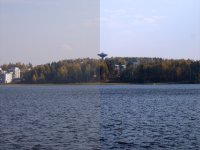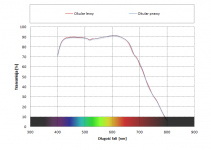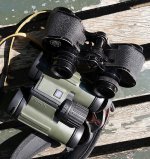NZbinodude
Well-known member

I received my first pair of 'real' binoculars at the age of 8. I'm 24 now - so it feels like a lifetime ago.
They had belonged to my late Grandfather. A pair of well-worn 6x30B Swedish military issue porros, made by Zeiss Obercochen. He'd acquired them during his career in the Swedish military.
Upon receiving them from my mother, I was probably too young to appreciate the fine mechanical quality, or to understand what the fancy ranging-reticle in the FOV was all about (I presumed all binoculars had them!) but I wasted no time scampering around the hills, scouring the tree tops for bellbirds, tuis, silvereyes and magpies. Countless summer afternoons were spent that way.
Fast forward to when I was about 18, and had the wherewithal to purchase something new and shiny, I bought my first pair of modern alphas. A pair of Zeiss Victory 10x32 T* FL's.
Most of you can probably remember some of your life's 'firsts'. Your first car. Your first romantic relationship. Your first fish/deer (if you're an avid sportsman). Your first parking ticket. Whatever.
Likewise, I can vividly remember the first time I glued those Victory's to my eyes. It was an optical roller-coaster ride! "How good is thaaaat?!" Everything jumped out at me - tree limbs, birds, lamp posts. Whatever I looked at seemed to 'pop' out of the background. I was convinced my binoculars possessed some kind of magic, and that I was only a few short steps away from ruling the world.
Unfortunately, I caught that disease. My urge to have the latest and greatest lead me to ditch the 10x32 Victory FL's for a pair of Leica Geovid HDB's. The Geovids were then traded for a pair of Swarovski EL 8.5x42's, and they were traded for a pair of 8.5x42 Field Pros.
For some reason, none of the binoculars I've owned (or tried) since selling the 10x32 Victory FL's, have given me that 'pop' effect. The strong separation of foreground/background. Optical punch. I'm not sure of the correct technical terms?
A part of me wonders if I've become desensitized to good quality glass ? Prior to purchasing the 10x32 Victory FL's, I'd been using an optically inferior vintage instrument, which would have made the FL's seem exceptionally good in comparison. This may have been responsible for my initial positive impression (the sensation of the image through the binos 'coming alive' and 'popping').
But another part of me wonders if that 'pop' effect was due to some special optical design or feature, present in the Zeiss Victory FL's, but absent in the Leicas and Swarovski EL's?
Unfortunately there are no FL's available in NZ for me to look through. So I might have to purchase another and cross my fingers that they'll live up to my rosy recollections of the first pair.
Perhaps somebody can enlighten me. Or slap me in the face (virtually). Lol
Cheers.
They had belonged to my late Grandfather. A pair of well-worn 6x30B Swedish military issue porros, made by Zeiss Obercochen. He'd acquired them during his career in the Swedish military.
Upon receiving them from my mother, I was probably too young to appreciate the fine mechanical quality, or to understand what the fancy ranging-reticle in the FOV was all about (I presumed all binoculars had them!) but I wasted no time scampering around the hills, scouring the tree tops for bellbirds, tuis, silvereyes and magpies. Countless summer afternoons were spent that way.
Fast forward to when I was about 18, and had the wherewithal to purchase something new and shiny, I bought my first pair of modern alphas. A pair of Zeiss Victory 10x32 T* FL's.
Most of you can probably remember some of your life's 'firsts'. Your first car. Your first romantic relationship. Your first fish/deer (if you're an avid sportsman). Your first parking ticket. Whatever.
Likewise, I can vividly remember the first time I glued those Victory's to my eyes. It was an optical roller-coaster ride! "How good is thaaaat?!" Everything jumped out at me - tree limbs, birds, lamp posts. Whatever I looked at seemed to 'pop' out of the background. I was convinced my binoculars possessed some kind of magic, and that I was only a few short steps away from ruling the world.
Unfortunately, I caught that disease. My urge to have the latest and greatest lead me to ditch the 10x32 Victory FL's for a pair of Leica Geovid HDB's. The Geovids were then traded for a pair of Swarovski EL 8.5x42's, and they were traded for a pair of 8.5x42 Field Pros.
For some reason, none of the binoculars I've owned (or tried) since selling the 10x32 Victory FL's, have given me that 'pop' effect. The strong separation of foreground/background. Optical punch. I'm not sure of the correct technical terms?
A part of me wonders if I've become desensitized to good quality glass ? Prior to purchasing the 10x32 Victory FL's, I'd been using an optically inferior vintage instrument, which would have made the FL's seem exceptionally good in comparison. This may have been responsible for my initial positive impression (the sensation of the image through the binos 'coming alive' and 'popping').
But another part of me wonders if that 'pop' effect was due to some special optical design or feature, present in the Zeiss Victory FL's, but absent in the Leicas and Swarovski EL's?
Unfortunately there are no FL's available in NZ for me to look through. So I might have to purchase another and cross my fingers that they'll live up to my rosy recollections of the first pair.
Perhaps somebody can enlighten me. Or slap me in the face (virtually). Lol
Cheers.
Last edited:












